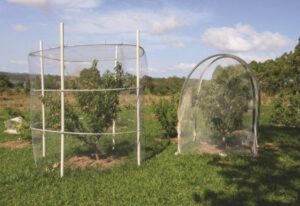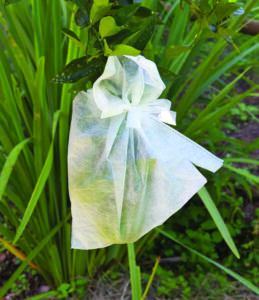
Crop protection: Wildlife’s safety net
By Gabrielle Stannus
From private residences to public landscapes, keeping out unwanted pests is just part of the job, and fundamentally good design. However, what if that ‘pest’ also happens to be a protected native species? If you are designing or maintaining a productive garden, make sure you know how to net fruit trees safely to avoid harm to Australia’s unique fauna.
When planning and designing for crop protection, prevention is better than cure. Netting is one way to exclude native and other animals from crops and edible gardens. However, not all netting is equal; indeed, some netting can be lethal. According to the wildlife rescue organisation WIRES, birds, bats, lizards, snakes and the occasional possum are the main victims of inappropriate netting. These and other animals can become tangled in, or trapped under, large mesh netting and become injured or worse if they cannot free themselves.
ACT bans large-gauge netting for residential use
In a bid to reduce netting-related injuries to wildlife, the Australian Capital Territory (ACT) government recently banned large-gauge netting in residential areas through its Nature Conservation Amendment Act 2023, with the new laws now in effect. Residential garden netting should have a mesh size of 5mm x 5mm or smaller at full stretch. Fines may be issued to residents and businesses who do not follow these laws. Retailers can still sell the large-gauge netting to commercial customers; however, they must display a sign in-store noting the residential ban. Residents caught continuing to use the prohibited netting after being told not to, may face fines of up to $800.
Similar legislation has been in force in Victoria since 1 September 2021. The Prevention of Cruelty to Animals Regulations 2019 requires that any netting used to protect household fruit trees, vegetable gardens or other fruiting plants in that State have a mesh size no greater than 5mm x 5mm at full stretch. The use of netting with a mesh size greater than 5mm x 5mm can result in a fine, and fines also apply to anyone advertising or offering for sale the wrong sized netting to protect household fruiting plants.

Smaller aperture netting is the way
When possums, birds and bats are helping themselves to our fruit, it can be hard to remember why they are protected under state and/or federal legislation. “It is definitely pesky when bats supplement their diet on backyard fruit, but they are really important pollinators and seed dispersers, and they do have a vital place in our ecosystem,” says Hannah van Alphen.
Together with Jenny Mclean, founder of the Tolga Bat Hospital, Hannah coordinates the Wildlife Friendly Fencing and Netting Project. “I have rescued bats, microbats, flying foxes, possums, gliders, waterbirds, lizards, and goannas, all from either large aperture netting or barbed wire fencing. So, it is a big problem that affects a lot of creatures. Smaller aperture netting really minimises the risk of entanglement,” advises Hannah.
However, Hannah warns that even this type of netting can be lethal if not installed properly: “If smaller aperture netting is not secured around the base of a tree or to a frame on the ground, then animals may become entrapped under it. Whilst that may not cause initial injury, if that animal remains trapped under the netting for a couple of days and is not found, then they will starve, become dehydrated or die of heat or cold exposure.”
Top tips for harm-free netting
“We cannot get rid of all netting. It serves a very important place in crop protection and damage mitigation; however, we can do it in more wildlife friendly ways,” says Hannah.
If designing or maintaining a productive garden, here are some tips to help you net your client’s fruit trees safely whilst avoiding harm to wildlife.

Take the ‘finger test’
Choose a net(s) with as small a mesh size as practicable to prevent access by small animals, and entanglement of larger animals’ wings or feet. The Wildlife Friendly Fencing and Netting Project recommends the ‘finger test’; i.e. choose netting that you cannot poke your finger through. The mesh size should be less than 5mm.
Select strong netting
Avoid thin, lightweight nets (e.g. extruded) as they are easy for animals to pull out of shape and become entangled, and are not very durable.
Choose a thick, strong net that does not stretch as this may result in animals becoming entangled. An ideal net is knitted or woven mesh made from thick strands (a minimum of 500 microns thick) of high-density polyethylene monofilament with woven selvedged edges.
Choose a lighter colour
Choose a net lighter in colour than the background foliage so birds and mammals can see it and avoid it.
If constructing an enclosure, choose roof and side nets that are as light in colour as possible to increase their visibility and reduce bird and mammal strikes. Also, ensure that any curtain ‘doors’ (i.e., made from a drop of net) are also taut, e.g., by weighing them down with a pipe weight.
To protect a whole tree, use a densely woven, white-coloured net that will not trap wildlife and does not need a frame, such as the Fruit Saver nets, Hail Guard or Vege Net. These nets are all white – the colour best seen by animals at night.
Fasten netting securely
Fix netting tightly to branches or tie onto the trunk – never throw it on loosely or allow it to lie on the ground where it can entangle reptiles and other animals. The net and its base should be taut enough so that it does not sink under the weight of animals, or form folds around them, when they land or crawl over it.

Net only what you need to
Pick fruit early and leave trees un-netted when possible, e.g., mangoes, paw paws, and bananas. Consider netting selected branches or fruit clusters only, rather than the entire tree. A range of bags, sleeves and socks are available to protect fruit this way.
“If it is just for personal use, can people get away with netting two branches instead of a whole tree? That will use significantly less meterage of netting as opposed to netting a whole tree,” says Hannah, “Individual fruit-saving bags save that bit of the crop for themselves and then share the rest with wildlife too.”

Check nets daily
Check trees daily while using netting to ensure no wildlife are entangled.
Remove nets after harvest
Remove netting from trees once fruit has been harvested or is over-ripe.
Select suitable varieties
Make it easier for your client to ‘do the right thing’ by selecting smaller fruit tree varieties that are easier to protect (net!), prune and harvest.
How the industry can support change
“Small aperture netting really should be gold standard. It is one of the ways to really mitigate the damage that netting can cause,” says Hannah.
Hannah and her fellow wildlife rescuers at the Wildlife Friendly Fencing and Netting Project would like to see mandatory labelling of backyard fruit trees at point of sale alerting the public to the dangers of using large aperture mesh netting. They would also like to see similar labelling of all netting at point of sale, showing the correct methods of its use, along with a warning about the legalities and penalties of harming wildlife.
Whilst an advocate for the use of small aperture nets, Hannah says that even those nets can be improved given they are made of plastic. “We are concerned, especially in the areas where that large aperture netting has been banned, about how much of plastic netting already exists and that there is not a single avenue to recycle it or repurpose it,” says Hannah. Current ‘best practice’ requires old nets to be disposed of by placing them into a strong biodegradable bag before putting into landfill, to avoid further harm to wildlife if left lying around a property. Hannah says that wildlife rescuers would like to see industry recycle old netting instead of it going to landfill.
Food for thought …
Closing the loop on plastic waste and avoiding harm to wildlife are ambitious yet very worthy goals. Demand from the public to grow their own food is only likely to increase in the future in response to ‘cost of living’ pressures and a desire to live more sustainably; we all saw the boom in household fruit and vegetable production associated with COVID-19. As professionals, we need to encourage and support the wider horticulture industry to make these changes, and to practice what we preach as we design, construct, and maintain landscapes and gardens.
Further information
For more information on safe and effective netting and fencing for wildlife, people and livestock, visit the Wildlife Friendly Fencing and Netting website: www.wildlifefriendlyfencing.org
What to do if you find an animal trapped in a net1?
Check your nets regularly. If an animal is caught, visit www.fauna.org.au to find a wildlife carer in your area.
Never attempt to untangle and release any native wildlife that has become entangled or entrapped in any netting or fencing. Attempting to free an animal should be left to a trained and experienced wildlife rescuer to minimise the risk of further damage to the animal, or injury to the member of the public who finds the animal. This is especially important regarding the handling of bats; only people who are vaccinated against Australian Bat Lyssavirus (ABLV) and permitted by law to handle bats should do so. Even if an animal seems uninjured, it should never be untangled and then immediately be released, as constriction injuries can deteriorate dramatically over five to seven days, leaving an animal, disfigured, or unable to fly or feed, to die a slow and agonising death if left in the wild.
Gabrielle Stannus
Inwardout Studio
M: 0400 431 277
E: gabrielle@inwardoutstudio.com
References
NB. In addition to the Wildlife Friendly Fencing and Netting Project, the advice in this article has come from the following sources:
Animal Welfare Victoria. (2021, July). Harvest without Harm [Brochure].
Government of South Australia. (2018, March 15). Wildlife-friendly permanent horticultural netting [Fact Sheet]. https://cdn.environment.sa.gov.au/environment/docs/wildlife-friendly-horticutural-netting-fact.pdf
WIRES (n.d.). Wildlife friendly netting. https://www.wires.org.au/wildlife-information/wildlife-friendly-netting
